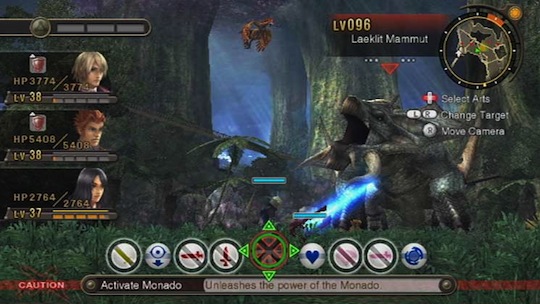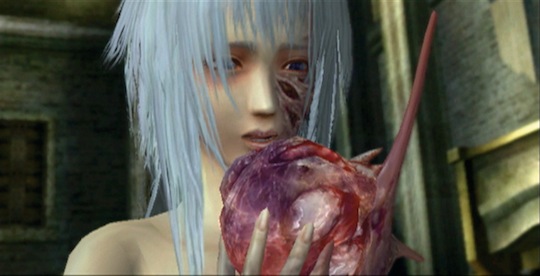
Nintendo's most recent console has long been lumbered with an image problem. Branded by turns a waggle machine, a shovelware platform and that system that doesn't have HD graphics, it's been largely ignored by self-professed "core" gamers, many of whom prefer to spend their time and money on bigger-budget titles with smaller pixels.
The thing is, throughout the Wii's lifespan it has been home to some great games, not just the low-budget, waggle-heavy crap that has formed the basis of the reputation it has today. Three of these quality titles have emerged in the system's dying days, and by golly if they aren't some of the best games of the entire console generation.
These three games, each developed by a different company and published by Nintendo in Japan and Europe, represent three very different takes on a genre described by many as stale and clichéd — the Japanese role-playing game. None of them have been designed to be million-sellers; instead, they're lovingly-crafted experiences which their developers have clearly poured their heart, soul, blood, sweat and tears into. They're designed as creative works rather than products, and they're all the better for it. And between them, they provide some of the finest, most original gameplay you'll find in this hardware generation — not to mention the rare and very welcome appearance of British accents outside of their usual home in the antagonists' camp.
Read on to find out more.
Xenoblade Chronicles

Xenoblade Chronicles by MonolithSoft was the first of the three games to see an English language release, and has just crossed the pond to the States. Following the story of a longstanding war between the humanoid Homs and the mechanical Mechon, the game takes the form of a sprawling open-world adventure with seamless combat, several hundred sidequests and a truly loveable cast.
Xenoblade's take on the JRPG genre is similar to what Final Fantasy XII tried to do back in 2006 — put a "Western" spin on gameplay while keeping the aesthetic and narrative recognizably "J." It achieves this by quickly making it clear to the player that they're not expected to follow the game's narrative down a linear path for 40+ hours; instead, they're presented with well-realized locales populated with a huge variety of NPCs, each of whom has their own routine, personality and relationship with other residents of the area.
And of course, most of these NPCs have lost their kitten/magic sword/fragrant pink flowers and expect the player to rush off and find them in exchange for money, experience points and shiny objects. The quest log quickly fills with a wide variety of tasks which it's possible to tackle in any order — or indeed ignore completely and push on with the excellent story. Thanks to Xenoblade's convincing rendition of close-knit communities rather than towns simply being places that hold weapon, item and armor shops, though, most players will find themselves hard-pushed to turn down these requests. And in completing them, they'll find themselves learning more about the world in which they're adventuring.
And what a creative world it is. Rather than simply being another generic fantasy environment, Xenoblade's saga unfolds atop two giant titans frozen in time following their last great battle. Over thousands of years, plant and animal life has grown on them, making them seem like recognizable, relatable rolling landscapes from the perspective of the player. But every so often it's possible to catch a glimpse of the other titan in the distance, giving the game world an awe-inspiring sense of scale.
To reveal much more would be to spoil the sense of discovery inherent in the game; suffice to say that it's far from a conventional JRPG. Everything from the real-time MMO-style combat to the deep "affinity" system (in which players may develop relationships between every named NPC in the entire game) combines to produce a memorable, engrossing experience that will keep players busy for at least a hundred hours.
The Last Story

The Last Story from Mistwalker, the studio founded by Final Fantasy creator Hironobu Sakaguchi, was the second of the three titles to be released in English. It's due out on June 19 in the States, to be published by Xseed Games rather than Nintendo.
The Last Story provides a totally different take on the genre to Xenoblade Chronicles. Rather than providing a sprawling open world in which players may discover their own adventures for upwards of a hundred hours, it presents a tightly-scripted, cinematic and mostly linear experience that is over within 30 hours. In the process, it manages to be one of the most pacy stories in role-playing game history, and is all the better for it.
The game casts players in the role of Zael, a member of a band of mercenaries who have come to Lazulis Island to do a job for the local duke. As the game's story unfolds, there's plenty of war, romance and tragedy — it's a fantasy epic of the highest order, though manages to restrain itself from the usual godslaying excesses often seen in the genre. It's a strong, character-driven tale with very little downtime and absolutely no grinding required.
Unlike many other RPGs — both Western and Japanese — there is no "filler" in The Last Story. Every combat is a scripted setpiece rather than a throwaway enemy encounter; sometimes players will find themselves taking cover and sniping far-off enemies with a crossbow, at other times they will be leaping out from the shadows to ambush patrols, at others still they will be charging into an impressively-large melee supported by a large force of companions.
Combat unfolds in real-time, with players taking direct control of Zael. As the game progresses, the player unlocks the ability to issue commands to their companions in a light real-time strategy style, and an awareness of the battlefield in three dimensions is necessary to succeed. Glance up and see a precarious stalactite, for example, and it's a simple matter to order magic-casting companions to bring it tumbling down on enemies' heads.
When the player is not proceeding through the game's fairly linear dungeons — which are mostly pathways between the game's signature setpiece fights — they are free to explore one of the most well-realized cities of any game. Around Lazulis City are numerous sidequests and hidden treasures to uncover, but none of this is necessary to get a satisfying experience from the game. Rather, completing these sidequests simply adds a feeling of depth to the setting that truly helps the player to feel invested in the ongoing narrative.
Combine all this with the deep visual customization of the game's characters; the fun take on equipment where items are upgraded rather than replaced (and change their appearance to become increasingly badass in the process); Nobuo Uematsu's stirring soundtrack; and the surprisingly entertaining multiplayer mode, and you have a brilliantly-paced game perfect for those who enjoy the JRPG genre but don't have the time to invest in a 100+ hour epic.
Pandora's Tower

Finally, Pandora's Tower from Ganbarion was the most recent title to see an English language release. At the time of writing, it's only been available in Europe for a day, and a Stateside release is still unconfirmed. Of the three games, it's the furthest away from the "traditional" JRPG format, and the title likely to prove the most divisive among critics and players thanks to its small-scale, intimate narrative and strange combination of genres.
Pandora's Tower casts players in the role of Aeron, a young almost-but-not-quite mute hero who would do anything to save his waif-like girlfriend Elena from the curse she is suffering. Elena is fated to turn into a large slobbering betentacled slug-like creature, and it's only by eating the flesh of the "Masters" of thirteen mysterious towers than she can recover. Aeron, being the one with the sharp sword and the mysterious magic chain (provided to him by a strange old woman carrying a skeleton in a jar on her back) gets the dubious honor of challenging these towers in order to save his love, whom he also mustn't forget to shower with gifts and affection between dungeon jaunts.
The game unfolds via a curious blend of Castlevania: Lords of Shadow-style character action combat; Ico-style environmental puzzling; Shadow of the Colossus-style giant monster-bashing; Dark Souls-style bleakness; a deep crafting system; and dating sim elements. Players explore the towers from fixed camera perspectives, battling monsters and determining the best ways to negotiate the numerous obstacles on the way to the tower's boss.
It's the addition of the chain weapon that makes Pandora's Tower so interesting; while it can be used as a Zelda-style grappling hook, it may also be used to inflict all manner of unpleasantness on the enemies in the tower. Chain two monsters together, for example, and any damage inflicted on one will rattle down the chain and hurt the other. Chain a cowardly monster to a stone pillar to prevent them running away. Wrap a monster in the chain, pull it tight then flick the Wii Remote to tear off chunks of flesh which can be taken back to Elena to temporarily stave off the curse's progression.
Pandora's Tower forces players to consider time management in a way that hasn't been seen in a game like this since Majora's Mask. Should they push on to the boss in the hope they can secure a quick victory? Or should they race back through the tower with a bag full of dripping entrails to ensure Elena doesn't suffer more than she has to? These decisions become tougher as the dungeons become more complex, as ensuring that Aeron and Elena have a good relationship is essential to see the game's best ending.
The strange blend of genres seen in Pandora's Tower make it likely to become the "cult classic" of the three. It's certainly a highly inventive take on the action RPG/character action genre, and its intimate small-cast story gives it a very distinctive atmosphere that is worlds away from what many have come to expect from Japanese games.
Those who have found themselves drifting away from the mainstream or frustrated by the increasing dominance of "business" over "creativity" in high-profile titles should look to these three games for some degree of comfort. They're complete, self-contained works without a hint of the industry's current controversies — no online passes, no DLC, no cut corners in the name of hitting a publisher's tight schedule — and provide some of the most satisfying experiences you'll have in the current console generation. For that, they should be applauded and supported, regardless of the platform they're on or the resolution they run at.
To do just that, order a copy of Xenoblade Chronicles here, preorder The Last Story from Amazon or GameStop and check out Operation Rainfall's efforts to secure a Stateside release for Pandora's Tower.
VentureBeat's mission is to be a digital town square for technical decision-makers to gain knowledge about transformative enterprise technology and transact. Learn More
